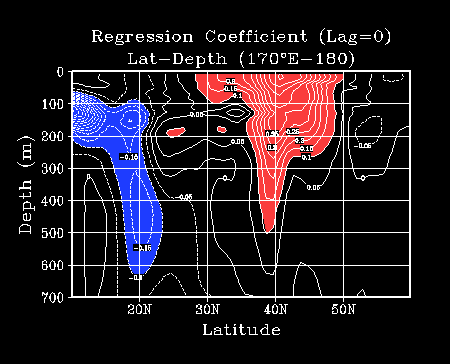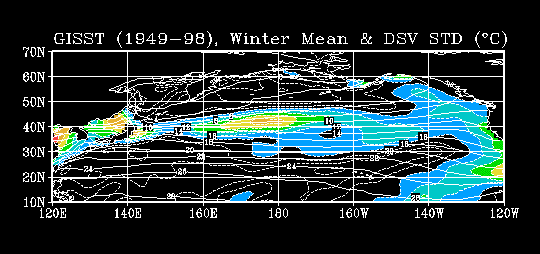4. Decadal-scale variability in observations
Geostrophic advection due to large-scale gyre circualtion plays a dominant role for the model DSV in the KOE region where the mixed layer is deep. Comparing the features of model DSV with those of the observed one, this section examines the effect of ocean dynamics to the real DSV in the KOE region and assesses the role of counterpart atmospheric thermal forcing. Since the vertical mixing process is not included in this OGCM, the differences between the model and observed DSVs may be partly attributed to the effect.
Fig. 5 Long-term (1949-98) wintertime mean SST (solid lines) and the rms of decadal variability (dotted lines). Regions with rms larger than 0.25°C are shaded.
There appears a center of action of DSV in the SAFZ near the date line in observations (cf. Nakamura et al. 1997; Tomita et al. 2000), which corresponds to the region with large rms of decadal mixed layer depth variability (Fig. 4). The other centers of action are in the Japan Sea, off the west coast of the North America, and in the region 160°-140°W, 30°-40°N, although the rms in the third reagion is relatively small. It is well known that the DSV in these centers of action is related with the activity of Aleutian Low in boreal winter (Trenberth and Hurrell 1994).
 Fig. 6 Long-term (1949-98) wintertime mean (solid lines) (a) SLP and
(b) surface wind, and the rms of their decadal variability (dotted lines).
Regions with rms larger than 0.25°C (0.8 m/s) are shaded in SLP (surface
wind) field.
Fig. 6 Long-term (1949-98) wintertime mean (solid lines) (a) SLP and
(b) surface wind, and the rms of their decadal variability (dotted lines).
Regions with rms larger than 0.25°C (0.8 m/s) are shaded in SLP (surface
wind) field.
In the SLP field, the center of large rms is located in the eastern part of Aleutian Low. Correspondingly, the large surface wind rms appears in the eastern North Pacific along the large rms in SLP. Near the center of action of DSV in the SAFZ (Fig. 5), however, the decadal variability of surface wind is relatively weak, so that we can not expect the large effect of atmospheric thermal forcing there.
Fig. 7 First EOFs of (a) observed DSV (56.5%) and (b) decadal 26.5s depth variability estimated from the SODA analysis data (45.6%), and (c) their time coefficients (green for SST and blue for isopycnal depth). In Fig. 7a, vectors indicate the regression coefficients of surface wind based on the time coefficient of the first EOF in observed DSV (solid green line). The unit is m/s.
A monopole pattern is pronounced in the EOF of observed DSV, although the EOF of model DSV exhibited a dipole pattern (Fig. 3). Whereas the spatial pattern of the EOF of decadal 26.5s depth variability again indicates the weaker-then-normal Kuroshio Extension and anomalous eastward currents north of 42°N, which implies the potential dipole pattern in the KOE region due to ocean dynamics as the EOF of model DSV shows (Fig. 3). However, the large wind anomalies in the southeastern part of monopole EOF pattern are favorable to locally modify the DSV anomalies from negative to positive through atmospheric thermal forcing such as surface heat flux forcing. The time coefficients of DSV EOF, which represent the time variation of the entire EOF pattern, thus do not have significant correlation with those of EOF of decadal 26.5s depth variability because the EOF pattern is locally modified by atmospheric thermal forcing.
Fig. 8 Normalized local time variation in the center of action (175°E-180, 39°N-44°N) of the observed DSV (red line), model DSV (blue line), and the decadal 26.5s depth variability estimated from the SODA analysis data (green line).
However, the local time variation of observed DSV has significant correlation with the model DSV (0.71) and the underlying decadal 26.5s depth variability (0.72) in the center of action in the SAFZ, indicating that geostrophic advection due to large-scale gyre circulation is still predominant for the DSV near the center of action of DSV in the SAFZ.
 Fig. 9 Latitude-depth section of temperature anomalies associated with
the DSV in the SAFZ. The anomaly field is estimated from regressein coeffeicients
based on the DSV time series in the center of action (red line in Fig. 8). Red (blue) color indicates regions with
values larger than (smaller than) 0.1°C (-0.1°C). Conter interval is 0.05°C.
Fig. 9 Latitude-depth section of temperature anomalies associated with
the DSV in the SAFZ. The anomaly field is estimated from regressein coeffeicients
based on the DSV time series in the center of action (red line in Fig. 8). Red (blue) color indicates regions with
values larger than (smaller than) 0.1°C (-0.1°C). Conter interval is 0.05°C.
Deep thermal structure is observed from 37°N to near 50°N centered at 40°N in the KOE region. Whereas the large temperature anomalies are confined to near surface shallower than 100 m to the south. In the former region, geostrophic advection regulates the temperature anomalies with vertical consistency as suggested by Deser et al. (1996) and Xie et al. (2000), while in the latter region, the temperature anomalies seem to be regulated by surface thermal forcing rather than large-scale gyre circulation.
Fig. 10 Anomalous fields of SSH and of subsurface currents at 100-m depth associated with the DSV in the center of action in the SAFZ. These anomaly fields are estimated from the regressein coeffeicients based on the DSV time series in the center of action (red line in Fig. 8) with lags -2, 0, and +2 years. The unit of vector is x10-4 cm/s.
In the midlatitude western Pacific, anomalous eastward or northward currents are pronounced especially along 40°N. Whereas in the region to the south of 40°N, the anomalous westward or southwestward currents are dominant, which indicates subsurface cold water advection from the northeast. The anomalous geostrophic currents well correspnd to the distribution pattern of anomalus SSH. The center of action of DSV in the SAFZ seems to be determined by both anomalous geostrophic currents and mixed layer depth distribution (Fig. 4).



